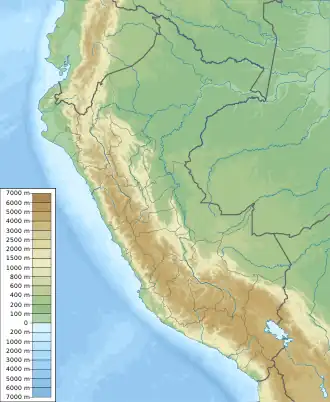Lake Sibinacocha
Lake Sibinacocha[1][2] (possibly from Quechua siwina whistle, qucha lake, lagoon)[3] is a lake in Peru. It is ranked as the 22nd[4] highest lake in the world. It is located in the Cusco Region, Canchis Province, Pitumarca District.[2] The lake is situated at a height of approximately 4,873 metres (15,988 ft), about 15.19 km long and 2.86 km at its widest point, and drains into the Amazon River.[5] Sibinacocha lies in the Vilcanota Range, south of Chumpe and southwest of Condoriquiña.[1]
| Lake Sibinacocha | |
|---|---|
 Lake Sibinacocha with Chumpe in the background | |
 Lake Sibinacocha | |
| Location | Cusco Region |
| Coordinates | 13°51′24″S 71°01′30″W |
| Basin countries | Peru |
| Max. length | 15.19 km (9.44 mi) |
| Max. width | 2.86 km (1.78 mi) |
| Surface elevation | 4,873 m (15,988 ft) |
| Website | The Sibinacocha Watershed Project |
| Sibinacocha Dam | |
|---|---|
 | |
 Location of Sibinacocha Dam in Peru | |
| Opening date | 1996 |
| Dam and spillways | |
| Type of dam | Earthen dam |
| Height | 12 m (39 ft) |
| Length | 357 m (1,171 ft) |
| Reservoir | |
| Total capacity | 110,000,000 m3 (89,000 acre⋅ft) |
| Power Station | |
| Operator(s) | EGEMSA |
| Website Represa de Sibinacocha | |
The lake contains Inca artifact, some of which have been recovered from the lake.[5] Sacred sites around the lake have been studied as possible locations of the lost Ausangate temple.[6] The area has been studied for its importance to the greater Urubamba-Vilcanota watershed.[6] A high-altitude diver, Geoffrey Belter, died in 2014 while exploring the lake.[6]
An earthen dam was erected at the lake in 1996.[7] It is 357 m (1,171 ft) long and 12 m (39 ft) high.[7] The reservoir has a volume of 50,000 m3 (41 acre⋅ft) and a capacity of 110,000,000 m3 (89,000 acre⋅ft).[7] It is operated by EGEMSA.[7]
See also
References
- Peru 1:100 000, Ocongate (28-t). IGN (Instituto Geográfico Nacional - Perú).
- escale.minedu.gob.pe - UGEL map of the Canchis Province (Cusco Region)
- Teofilo Laime Ajacopa (2007). Diccionario Bilingüe: Iskay simipi yuyayk’anch: Quechua – Castellano / Castellano – Quechua (PDF). La Paz, Bolivia.
{{cite book}}: CS1 maint: location missing publisher (link) - Drews, Carl. "The Highest Lake in the World". www.highestlake.com/. Archived from the original on 18 August 2012. Retrieved 2 September 2012.
- Michelutti, Neal; Sowell, Preston; Tapia, Pedro M.; Grooms, Christopher; Polo, Martin; Gambetta, Alexandra; Ausejo, Carlos; Smol, John P. (16 December 2019). "A pre-Inca pot from underwater ruins discovered in an Andean lake provides a sedimentary record of marked hydrological change". Scientific Reports. 9 (1): 19193. Bibcode:2019NatSR...919193M. doi:10.1038/s41598-019-55422-1. PMC 6915777. PMID 31844075.
- Aikman, Jim (2020-02-04), Lost Temple of the Inca (Documentary), Bedrock Film Works, Off the Fence, retrieved 2022-09-16
- Recursos Hídricos del Perú en Cifras (in Spanish). Autoridad Nacional del Agua / MINAG - Perú. 2010. p. 58.